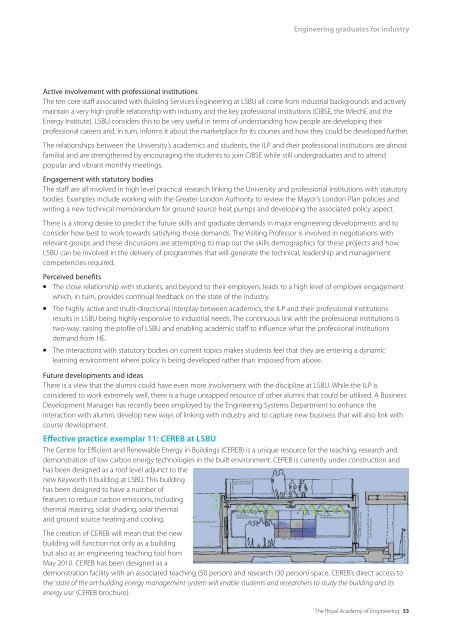Engineering graduates for industry - Royal Academy of Engineering
Engineering graduates for industry - Royal Academy of Engineering
Engineering graduates for industry - Royal Academy of Engineering
Create successful ePaper yourself
Turn your PDF publications into a flip-book with our unique Google optimized e-Paper software.
<strong>Engineering</strong> <strong>graduates</strong> <strong>for</strong> <strong>industry</strong><br />
Active involvement with pr<strong>of</strong>essional institutions<br />
The ten core staff associated with Building Services <strong>Engineering</strong> at LSBU all come from industrial backgrounds and actively<br />
maintain a very high pr<strong>of</strong>ile relationship with <strong>industry</strong> and the key pr<strong>of</strong>essional institutions (CIBSE, the IMechE and the<br />
Energy Institute). LSBU considers this to be very useful in terms <strong>of</strong> understanding how people are developing their<br />
pr<strong>of</strong>essional careers and, in turn, in<strong>for</strong>ms it about the marketplace <strong>for</strong> its courses and how they could be developed further.<br />
The relationships between the University’s academics and students, the ILP and their pr<strong>of</strong>essional institutions are almost<br />
familial and are strengthened by encouraging the students to join CIBSE while still under<strong>graduates</strong> and to attend<br />
popular and vibrant monthly meetings.<br />
Engagement with statutory bodies<br />
The staff are all involved in high level practical research linking the University and pr<strong>of</strong>essional institutions with statutory<br />
bodies. Examples include working with the Greater London Authority to review the Mayor’s London Plan policies and<br />
writing a new technical memorandum <strong>for</strong> ground source heat pumps and developing the associated policy aspect.<br />
There is a strong desire to predict the future skills and graduate demands in major engineering developments and to<br />
consider how best to work towards satisfying those demands. The Visiting Pr<strong>of</strong>essor is involved in negotiations with<br />
relevant groups and these discussions are attempting to map out the skills demographics <strong>for</strong> these projects and how<br />
LSBU can be involved in the delivery <strong>of</strong> programmes that will generate the technical, leadership and management<br />
competencies required.<br />
Perceived benefits<br />
● The close relationship with students, and beyond to their employers, leads to a high level <strong>of</strong> employer engagement<br />
which, in turn, provides continual feedback on the state <strong>of</strong> the <strong>industry</strong>.<br />
●<br />
●<br />
The highly active and multi-directional interplay between academics, the ILP and their pr<strong>of</strong>essional institutions<br />
results in LSBU being highly responsive to industrial needs. The continuous link with the pr<strong>of</strong>essional institutions is<br />
two-way: raising the pr<strong>of</strong>ile <strong>of</strong> LSBU and enabling academic staff to influence what the pr<strong>of</strong>essional institutions<br />
demand from HE.<br />
The interactions with statutory bodies on current topics makes students feel that they are entering a dynamic<br />
learning environment where policy is being developed rather than imposed from above.<br />
Future developments and ideas<br />
There is a view that the alumni could have even more involvement with the discipline at LSBU. While the ILP is<br />
considered to work extremely well, there is a huge untapped resource <strong>of</strong> other alumni that could be utilised. A Business<br />
Development Manager has recently been employed by the <strong>Engineering</strong> Systems Department to enhance the<br />
interaction with alumni, develop new ways <strong>of</strong> linking with <strong>industry</strong> and to capture new business that will also link with<br />
course development.<br />
Effective practice exemplar 11: CEREB at LSBU<br />
The Centre <strong>for</strong> Efficient and Renewable Energy in Buildings (CEREB) is a unique resource <strong>for</strong> the teaching, research and<br />
demonstration <strong>of</strong> low carbon energy technologies in the built environment. CEREB is currently under construction and<br />
has been designed as a ro<strong>of</strong> level adjunct to the<br />
new Keyworth II building at LSBU. This building<br />
has been designed to have a number <strong>of</strong><br />
features to reduce carbon emissions, including<br />
thermal massing, solar shading, solar thermal<br />
and ground source heating and cooling.<br />
The creation <strong>of</strong> CEREB will mean that the new<br />
building will function not only as a building<br />
but also as an engineering teaching tool from<br />
May 2010. CEREB has been designed as a<br />
demonstration facility with an associated teaching (50 person) and research (30 person) space. CEREB’s direct access to<br />
the ‘state <strong>of</strong> the art building energy management system will enable students and researchers to study the building and its<br />
energy use’ (CEREB brochure).<br />
The <strong>Royal</strong> <strong>Academy</strong> <strong>of</strong> <strong>Engineering</strong> 33

















